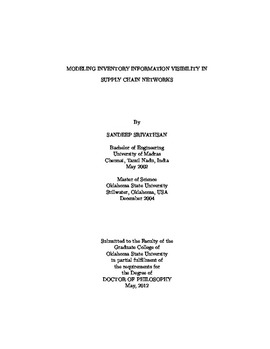| dc.contributor.advisor | Kamath, Manjunath | |
| dc.contributor.author | Srivathsan, Sandeep | |
| dc.date.accessioned | 2013-12-10T18:05:06Z | |
| dc.date.available | 2013-12-10T18:05:06Z | |
| dc.date.issued | 2012-05 | |
| dc.identifier.uri | https://hdl.handle.net/11244/7782 | |
| dc.description.abstract | Scope and Methods: The stock-out rate at a store has become a serious concern for firms in a supply chain network (SCN). This situation can lead to loss in customer good will and market share. Information sharing among the SCN partners is seen as a strategy to address this problem and we studied inventory visibility or the sharing of inventory information among the supply chain constituents. This research focused on developing performance evaluation models of two "building-block" type SCN configurations (one retail store and two production facilities, and two retail stores and two production facilities) under three levels of inventory visibility (LoVis, MedVis and HiVis). Our general approach was to first model the SCN under Poisson arrivals and exponential processing times. For this case, we initially used Continuous Time Markov Chain models. If this model did not yield a closed-form solution, then we developed approximate queueing models. We then extended these models to general inter-arrival and processing time distributions. We also studied the value of information sharing by comparing the results for the SCN configurations with and without information sharing. | |
| dc.description.abstract | Findings and Conclusions: In our research we have developed analytical models for two SCN configurations under three levels of information sharing. We solved the CTMC models numerically by fixing the maximum number of backorders. An M/M/2 based approximate queueing model for the SCN with HiVis was found to serve as a good approximation and provided useful bounds for the LoVis and MedVis cases. We then obtained correction factors based on analytical inferences and empirical observations to develop a modified M/M/2 model, which improved the performance prediction capability of the M/M/2 based model for the SCN with LoVis and MedVis. Our study on the value of information sharing showed that there is significance at lower base-stock levels and higher utilizations at the production facilities. The value was also found to be more sensitive to processing time variability than to inter-arrival time variability. We also developed analytical models for configurations with asymmetric production facilities under Poisson arrivals and exponential processing times. As an extension, we considered transit delays in the analytical models developed. Extensive numerical experiments indicated that the analytical models developed in our study yield accurate results (e.g., 90% of the results within a 15% error range) over a wide range of SCN parameter values when compared with simulation estimates. | |
| dc.format | application/pdf | |
| dc.language | en_US | |
| dc.rights | Copyright is held by the author who has granted the Oklahoma State University Library the non-exclusive right to share this material in its institutional repository. Contact Digital Library Services at lib-dls@okstate.edu or 405-744-9161 for the permission policy on the use, reproduction or distribution of this material. | |
| dc.title | Modeling inventory information visibility in supply chain networks | |
| dc.contributor.committeeMember | Sharda, Ramesh | |
| dc.contributor.committeeMember | Ingalls, Ricki Gene | |
| dc.contributor.committeeMember | Liu, Tieming | |
| dc.contributor.committeeMember | Balasundaram, Balabhaskar | |
| osu.filename | Srivathsan_okstate_0664D_12101.pdf | |
| osu.accesstype | Open Access | |
| dc.type.genre | Dissertation | |
| dc.type.material | Text | |
| dc.subject.keywords | base-stock policy | |
| dc.subject.keywords | Continuous Time Markov Chain (CTMC)) | |
| dc.subject.keywords | inventory visibility | |
| dc.subject.keywords | queueing model | |
| dc.subject.keywords | supply chain network | |
| thesis.degree.discipline | Industrial Engineering and Management | |
| thesis.degree.grantor | Oklahoma State University | |
